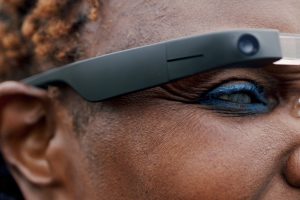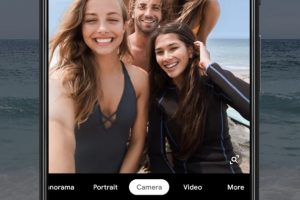The headline features include new and better cameras, a reworking of the Google Assistant, so it doesn’t take up so much room on the screen and works better with other apps, an automatic captioning system, and 6GB of RAM and a 90hz display…
There’s also Motion Sense, courtesy of Infineon, as we previously covered:
“Pixel 4’s Motion Sense feature uses a miniature radar sensor to detect movement around your phone. It can sense when you’re reaching for the phone and will initiate face unlock, or turn off your screen when you’re not around. New Quick Gestures let you skip songs when you don’t want to pick up your phone. Just wave your hand to snooze alarms, dismiss timers, or silence your phone ringer. Motion Sense is enabled everywhere Pixel 4 is sold, except in Japan where it’s coming soon.”
Note that the Pixel 4 doesn’t ship with earphones or a 3.5mm adapter, highlights PhoneArena.
Pixel 4 specs
In terms of the specs, it makes sense to begin with the displays. The Pixel 4 has a 5.7″ (144.7mm) FHD+ flexible OLED display (444 ppi, 19:9 aspect ratio, running at up to 90Hz), while the Pixel 4 XL has a 6.3″ (160.0mm) QHD+ flexible OLED display (537 ppi, 19:9 aspect ratio, 90Hz).
For the main processors, both versions run on a 64-bit Octa-Core Qualcomm Snapdragon 855 (2.84 GHz), with a Qualcomm Adreno 640 (1.78 GHz) for the GPU. In terms of memory, they both have 6 GB LPDDR4x of RAM and 64GB or 128GB of storage.
For comms, they both support Wi-Fi 2.4 GHz + 5 GHz 802.11 a/b/g/n/ac 2×2 MIMO, Bluetooth 5.0 + LE (HD codecs: AptX, AptX HD, LDAC), NFC, and GPS, GLONASS, BeiDou, and Galileo.
Miscellaneously, they will both run the latest Android (with a guaranteed minimum three years of OS and security updates). For augmented reality apps, they both run Google’s own ARCore, and they both have three cameras, the main rear one being HDR+ 16 MP, with 1.0 μm pixel width and ƒ/2.4 aperture, with 52° field of view. There’s also optical and electronic image stabilisation.
The Pixel 4 weighs 162g, and the XL 193g.
Phew. Full details, for serious perusal, can be found online.
Pricing and availability
The phones will ship on October 24, globally, says Google. And you can pre-order a Pixel 4 for $799 and Pixel 4 XL for $899.
The Pixel 4 comes in three colours: Clearly White, Just Black, and a limited edition Orange.
Live Caption
The launch of Pixel 4 also marked the official availability of Live Caption, an automatic captioning system that is intended to be nimble enough to work on a smartphone. It is, says Google, designed “to make digital media more accessible”.
“With a single tap, Live Caption automatically captions videos and spoken audio on your device (except phone and video calls). It happens in real time and completely on-device, so it works even if you don’t have cell data or Wi-Fi, and the captions always stay private and never leave your phone.”
As well as the new phone, Google says Live Caption will roll out to the Pixel 3, Pixel 3 XL, Pixel 3a and Pixel 3a XL “later this year”, and it says it’s working with other Android phone manufacturers to make it “more widely available in the coming year”.
Pixelbook Go
Google also released a Chromebook, the Pixelbook Go.
Priced at $649, you can’t really call it affordable, but it comes in mid-range compared to 2017’s Pixelbook ($999).
Despite being thicker than the original Pixelbook, measuring 13.4mm rather than 10.3mm, it is very slightly lighter.
Whether you’re running to a class or a meeting, the grippable design of Pixelbook Go makes it easy to carry, and up to 12 hours of battery life keeps the laptop running as long as you are. Even better, you’ll get two hours of battery on just 20 minutes of charging. Made for Google sleeves and these general care suggestions can help keep your Pixelbook Go in tip-top shape.
A huge part of the design of any laptop is its keyboard. Nobody wants to be that loud typer clacking away at their local coffee shop. We took the premium keyboard from Pixelbook and made it more affordable. So rest assured loud typers, we’ve got your back with our quiet Hush Keys.
Pixelbook Go pre-orders have started being taken in the U.S. and Canada. It will be January for the U.K. pre-orders.
Pixel Buds
Also part of the large-scale product announcement were the earphones, Pixel Buds.
“Pixel Buds have a unique hybrid design that keeps you aware of the world around you, while still delivering powerful sound. The eartips gently seal the ear to isolate the loud outside noises, and to give high quality audio. The spatial vent underneath reduces that plugged-ear feeling, and lets through just the right amount of environmental sound so you can stay aware of the things around you. Pixel Buds also have Adaptive Sound, which dynamically adjusts the volume as you move from a quiet environment to a noisy one, so you don’t have to constantly raise or lower the volume.”
“Pixel Buds automatically detect when they’re in your ear and each earbud gives you handy touch controls: just tap to play or pause, and swipe to adjust volume. With Pixel Buds, you get 5 hours of listening time on a single charge, with up to 24 hours with the wireless charging case. They are sweat and water resistant, so rainy days and intense workouts are no problem.”
They will be available next year in the U.S. at $179.
So. Farewell then Google Clips
Finally, just to record the fact, Google has pulled its Clips, the mini AI-powered camera. Apparently, according to Engadget, first-generation Pixel Buds and the Daydream View have also gone from the Google Store.
See also: Infineon’s 60GHz gesture recognition chip
 Electronics Weekly Electronics Design & Components Tech News
Electronics Weekly Electronics Design & Components Tech News



